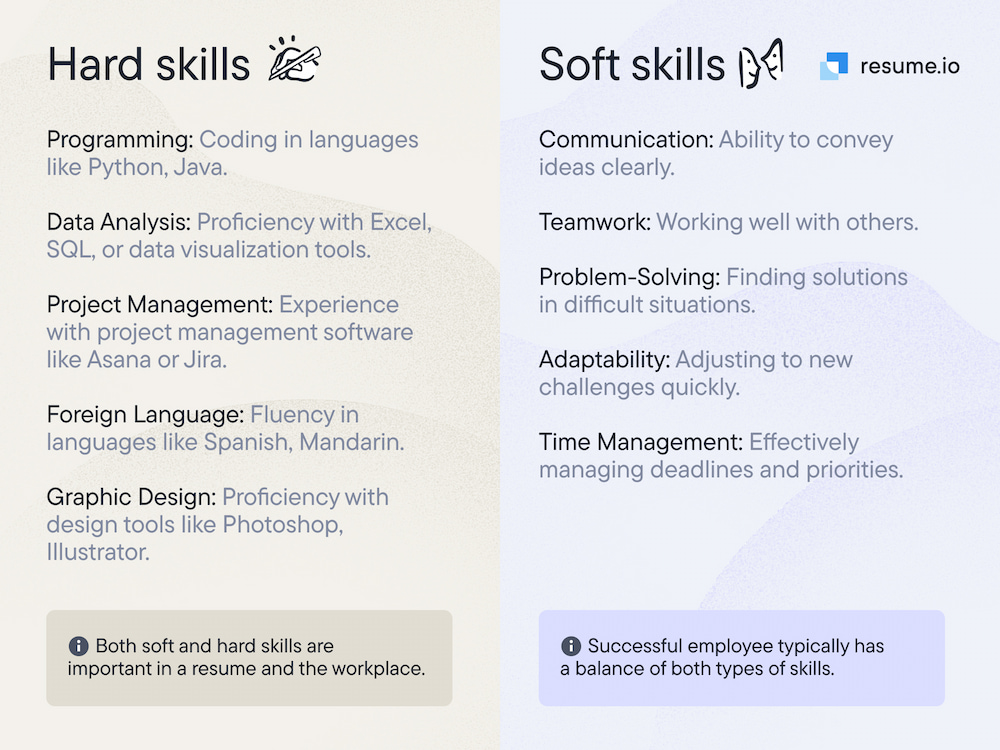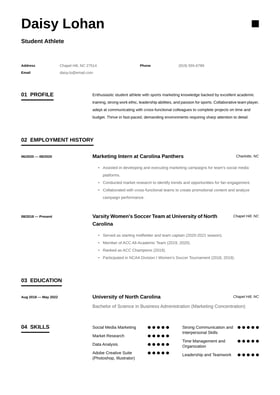Applying for your first job can be exciting—and a little scary. Writing your very first resume can bring up a lot of questions, like what you need to include and how you can stand out. Luckily, you don’t need years of experience to write a great resume.
We’ll show you how to make a resume for your first job, so that you can show employers that you’re ready to work.
How to make a resume for your first job
Creating a resume for the first time isn’t as difficult as you might think. Follow these steps to make a resume for your first job:
1. Choose the right format
Before you start writing, choose the best format for your resume. You have three options:
- Chronological. Most experienced professionals use the reverse chronological format, but it can also be a good choice for a first resume. Choose this format if you have some non-work experience, such as volunteer or school projects, that you want to highlight.
- Functional. A functional resume prioritizes skills over employment history, making it a good choice for those with limited or no experience.
- Combination. Also known as a hybrid resume, a combination resume combines the functional and chronological formats. Use a combination resume if you want to showcase both your skills and your non-work experience or education.

Once you know the format you want to use, it’s time to design your resume. Create a new document with one-inch margins and choose a clean, simple font, such as Arial or Times New Roman. Make sections for your resume header, summary or objective, education, non-work experience, and skills. We’ll go over each resume part in more detail below.
Use a resume builder for a fast, professional resume
If you don’t want to make a resume from scratch, start with our ai resume builder. All you need to do is choose your resume template and fill out some basic information. In the builder, you can even reorder sections or create new ones, depending on what you want to highlight on your first resume.
2. Create a resume header
Your resume needs a header with your contact information, so that employers know how to reach you for an interview. The header goes at the top of your resume. It should feature your first and last name in a big, bold font to help it stand out.
Below your name, the resume header also needs to include these elements:
- Your phone number. Provide the best phone number for a recruiter to reach you.
- Your email address. Use a professional email address for your job search. If you don’t have one, create an email that uses your name or initials.
- Location. Don’t provide your full mailing address. Just list your city and state.
- LinkedIn profile. If you have an up-to-date LinkedIn page with your education and skills, you can include a link in your resume header.
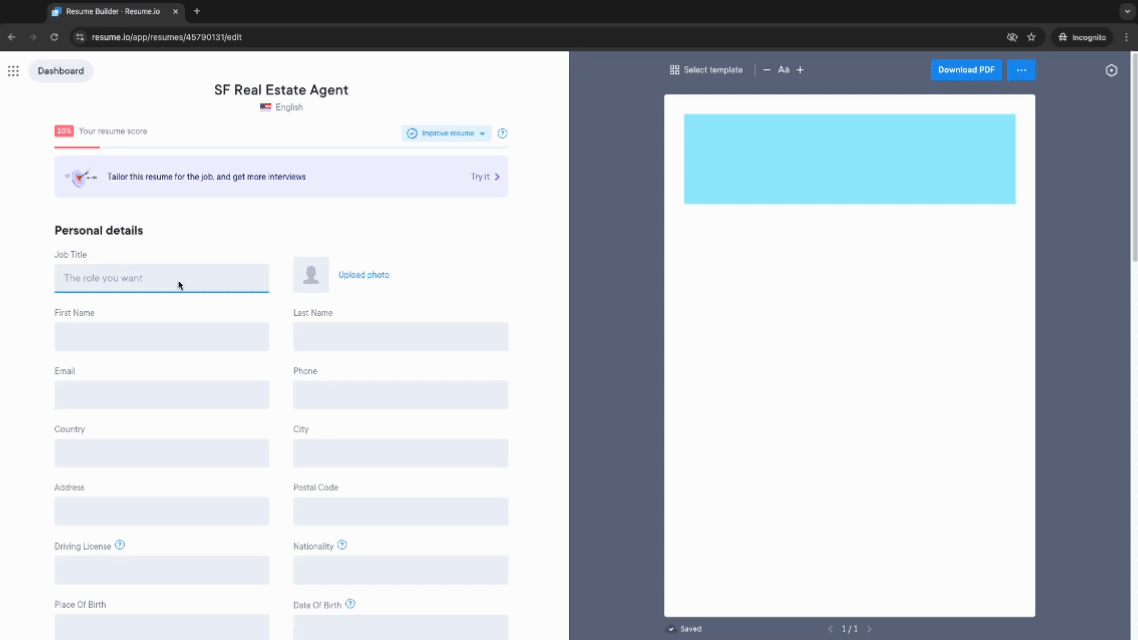
3. Write a summary or objective

Below your resume header, write a short paragraph about your strengths and talents. Known as a resume summary, this statement gives you a chance to explain why an employer should consider hiring you, even without experience.
For a first job resume, you can also write an objective statement instead of a summary. An objective focuses on your career goals and future ambitions. It can be helpful to include this information if you’re a recent graduate looking for your first job in the field.
Whether you write a summary or an objective, keep these tips in mind:
- Keep it short. A summary or objective statement should be no longer than three to four sentences. Your goal is to get a hiring manager’s attention quickly.
- Focus on your strengths. You have plenty of strengths that you can bring to your first job, like a positive attitude or a friendly personality. Emphasize these qualities to convince an employer that you’re worth hiring.
- Use strong verbs and adjectives. A summary or objective should use descriptive language. Include action verbs, like “contribute” or “lead,” and describe yourself positively, using adjectives such as “passionate” or “motivated.”
Motivated high school student with strong communication skills seeking a part-time job in retail. Eager to provide excellent customer service with a friendly smile and a positive attitude.
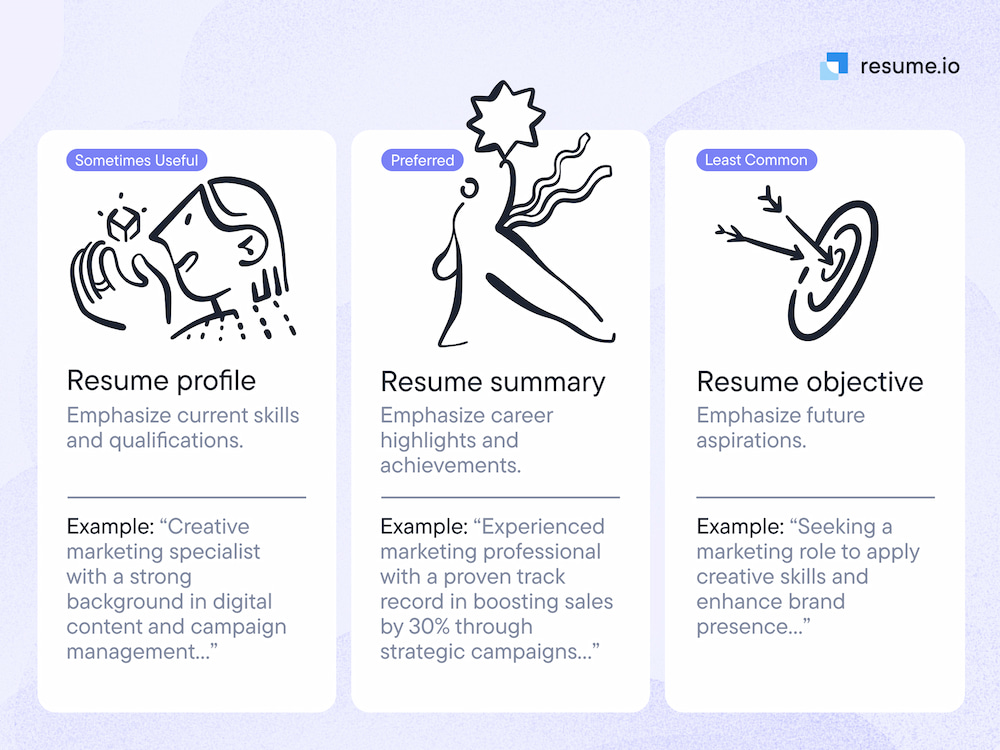
4. Highlight your education
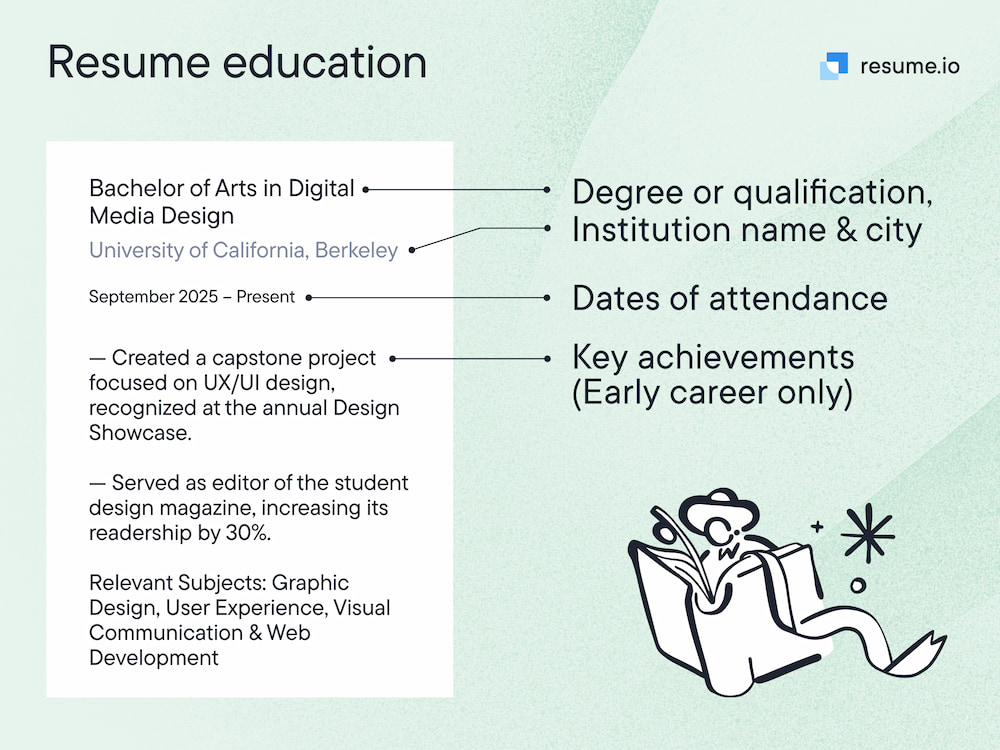
Without professional experience, your education should be a central focus of your first job resume. Create an education section below your resume summary or objective.
In this area, list your highest degree or diploma. Provide your graduation date or your expected graduation date if you’re still in school. If you’ve graduated college, you don’t need to list your high school diploma as well.
Along with these essential details, your education section can also include the following information:
- GPA. If you have a 3.5 GPA or above, highlight it on your resume. A high GPA can show employers that you’re motivated to work hard and do a good job.
- Relevant coursework. Mention classes you’ve taken that are relevant to the job you’re applying for. If you’re a marketing major applying for your first job, for example, you might discuss your coursework in digital media and social media marketing.
- School projects. If you’ve completed relevant projects in school, mention them in this section. For example, if you built an app for a college class, you can include it on your resume for your first software development job.
- Academic awards or honors. Did you graduate summa cum laude? Did you earn a prestigious scholarship? Were you named student of the month? You can put academic awards or honors in your education section.
- Extracurricular activities. You can also list any school activities and extracurriculars, such as sports teams, student government, or after-school clubs.
Bachelor of Arts in Communications
University of Tennessee
Expected graduation May 2025
- GPA: 3.8
- Coursework: Strategic communication, advertising and public relations, mass media, digital media production, and public speaking
5. Describe non-work experience
Even if you’ve never had a job, there may still be other experiences that you can put on your resume. Including relevant non-work experience can help highlight your transferable skills, such as organization or adaptability.
Some good examples of non-work experience for a first-time resume include:
- Internships. Completing an internship is a valuable way to gain real-world experience, so feature it prominently on your first job resume.
- Volunteer work. If you’ve volunteered at a nonprofit or charitable organization, list it on your resume as experience. Explain the skills you gained from volunteering, such as teamwork and communication.
- Personal projects. Have you built a website or social media profile with a sizable audience? Do you maintain a blog or newsletter? Have you created a detailed household budget? List relevant personal projects on your resume to show your drive and passion.
Volunteer | Bright Futures Foundation
January 2023 - Present
- Help low-income community members develop basic budgets and understand personal finance.
- Create handouts for monthly financial literacy workshops to explain different topics, such as credit scores and loans.
Personal Finance Blog Creator and Writer
September 2022 - Present
- Maintain a blog focused on budgeting tips and investment strategies for an audience of 15,000+ monthly visitors.
- Research topics and write blogs in clear language to break down complex financial information for a beginner audience.
6. Add your skills
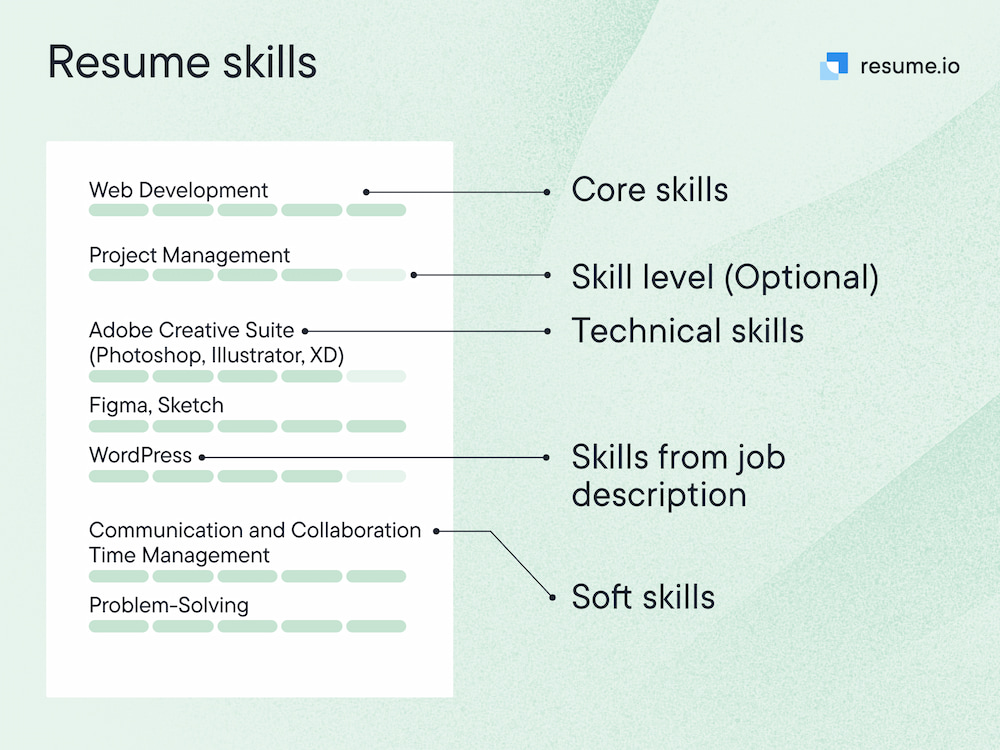
In the skills section, list the relevant areas where you shine. Your first resume should include a mix of both soft skills and hard skills.
Soft skills are the interpersonal traits that come naturally to you. For example, you might be a gifted communicator or an extremely organized person. Highlight these abilities on your resume to show an employer what type of employee you’d be.
These soft skills are common on a first-time resume:
- Communication
- Teamwork
- Adaptability
- Time management
- Organization
- Work ethic
- Problem solving
- Critical thinking
- Creativity
While you may not have professional work experience, you definitely have some hard skills you can include on your first resume as well. These are technical skills that you learn by doing. For example, knowing how to use Microsoft Office is a hard skill that you can mention on your resume.
Some good hard skills for a first-time resume might include:
- Google Workspace
- Microsoft Office
- Social media
- Graphic design
- Programming languages
- Data analysis
Find skills in the job description
A job description usually lists the skills that are most important to the employer. Make sure that you include some of those skills on your resume to show that you’re a good fit.
7. Consider additional sections
When writing your first resume, filling a whole page can feel like a struggle. In that case, consider including some optional sections to showcase your personality or other strengths. These sections should go at the bottom of your resume below your skills, education, and non-work experience.
Some optional sections for a first-time resume include:
- Languages. If you speak multiple languages, you can create a separate section to list them all, along with your proficiency levels.
- Hobbies or interests. Include your hobbies and interests if they’re relevant to the job. For example, if you’re applying for a lifeguard job, you can mention your passion for swimming and outdoor fitness activities.
- Certifications. Create a section to describe any certifications you’ve earned, such as CPR and first aid or a coding bootcamp certificate.
- Awards. If you’ve received any awards outside of school, mention them in an awards section.
Resume examples for a first job
Check out these related resume examples when making your first resume:
High school student resume
Teen resume
Student athlete resume
College student resume
College graduate resume
Tips for writing a first job resume
Crafting a stellar first resume can get your foot in the door and lead to more opportunities in the future.
Here are some additional tips for making your first-time resume stand out:
- Be honest. It might be tempting to embellish a few details here and there, especially when trying to get your first job. However, lying on your resume can result in serious consequences, including losing your job. Stick to the facts and focus on the skills you already have.
- Focus on your transferable skills. Even if you’ve never had a job, you have transferable skills that you can bring to the workforce. Your first resume should emphasize these skills, such as time management or creativity.
- Include keywords. Your resume might go through an applicant tracking system (ATS), which scans and ranks resumes based largely on keywords. Read the job description to find notable keywords and include those phrases on your resume to help it get past the ATS.
- Use strong action verbs. The right resume verbs can make you sound confident, powerful, and professional. For example, instead of saying “helped with” or “assisted,” use strong verbs like “contributed” or “collaborated.”
- Proofread your resume. A small mistake can be all it takes to get your resume tossed. Proofread your resume using online tools, such as Grammarly, or ask a detail-oriented friend to review it.
- Be kind to yourself. Above all, remember that everyone had a first resume at some point. Focus on your strengths, skills, and achievements, so that employers can see all that you have to offer.
First job resume FAQs
Here are the answers to other frequently asked questions about how to make a resume for your first job:
Do I need a resume for a first job?
Yes! Even if it’s a part-time or entry-level position, a resume shows that you’re a serious, professional candidate. It also allows you to highlight the skills and other experiences you have that make you a great fit for the role.
How long should a first job resume be?
Your first resume should be no longer than one page. Focus on your best qualifications, such as your education and skills. If you need to include more to fill out the page, mention relevant projects or volunteer work, your hobbies and interests, or any awards you’ve won.
How can I make a resume for a first job after a career break?
Re-entering the workforce after a break can feel daunting, even if you’re not technically applying for your first job. You can address employment gaps on your resume by explaining what you did during that time.
For example, if you left the workforce to raise a child or care for a family member, list that as experience on your resume. Discuss the relevant skills you used or gained during that time, such as budgeting, household management, and organization.


